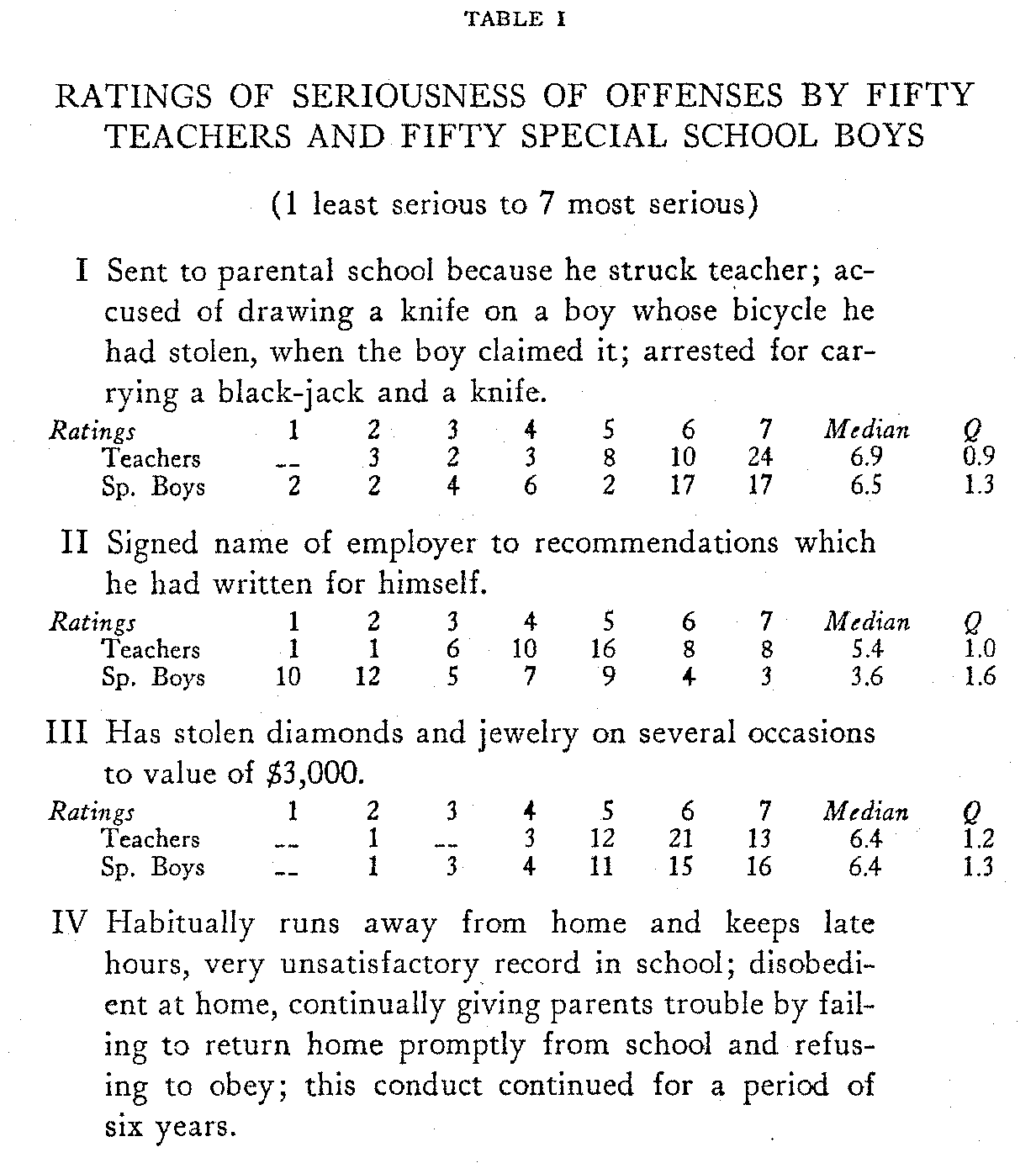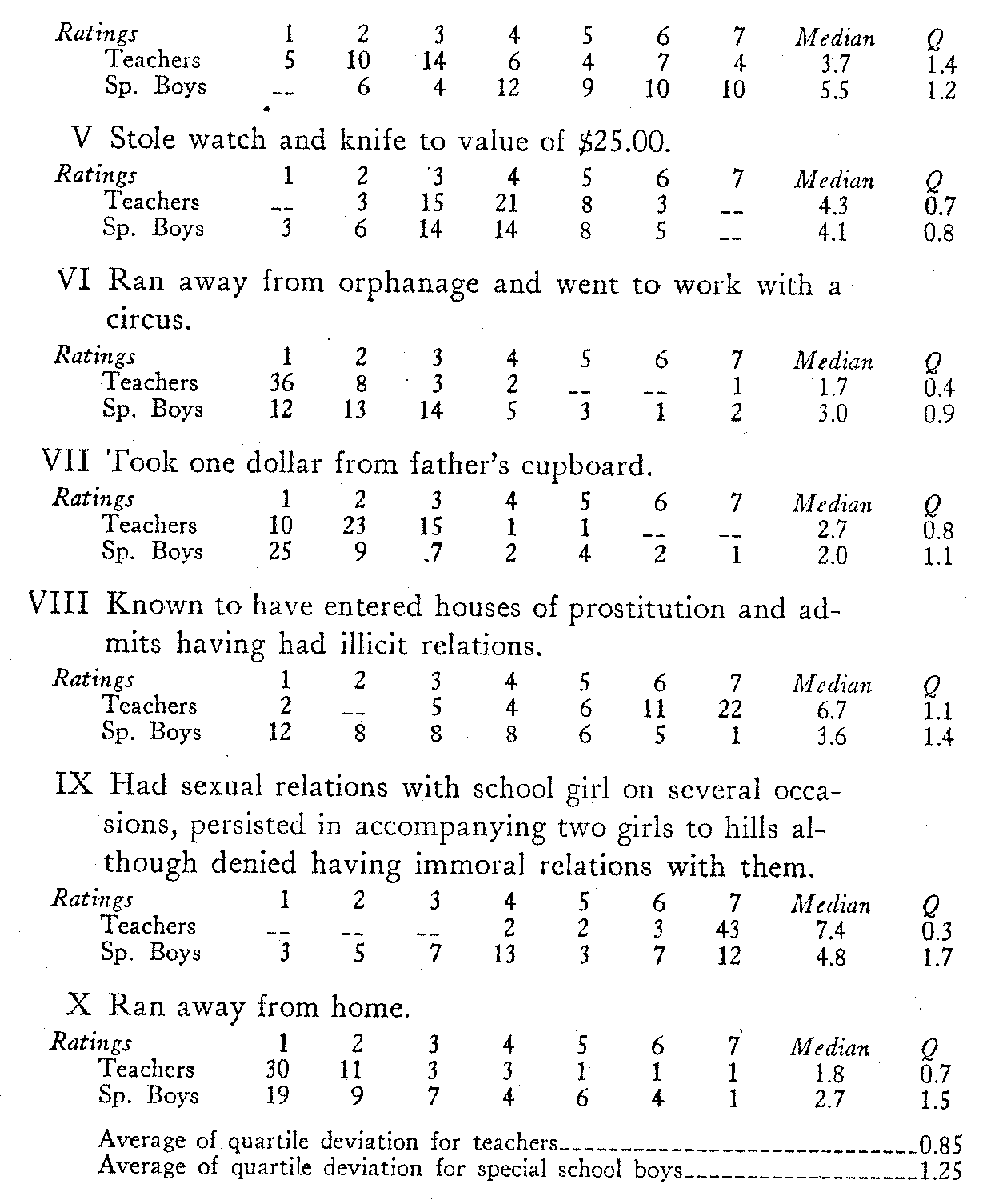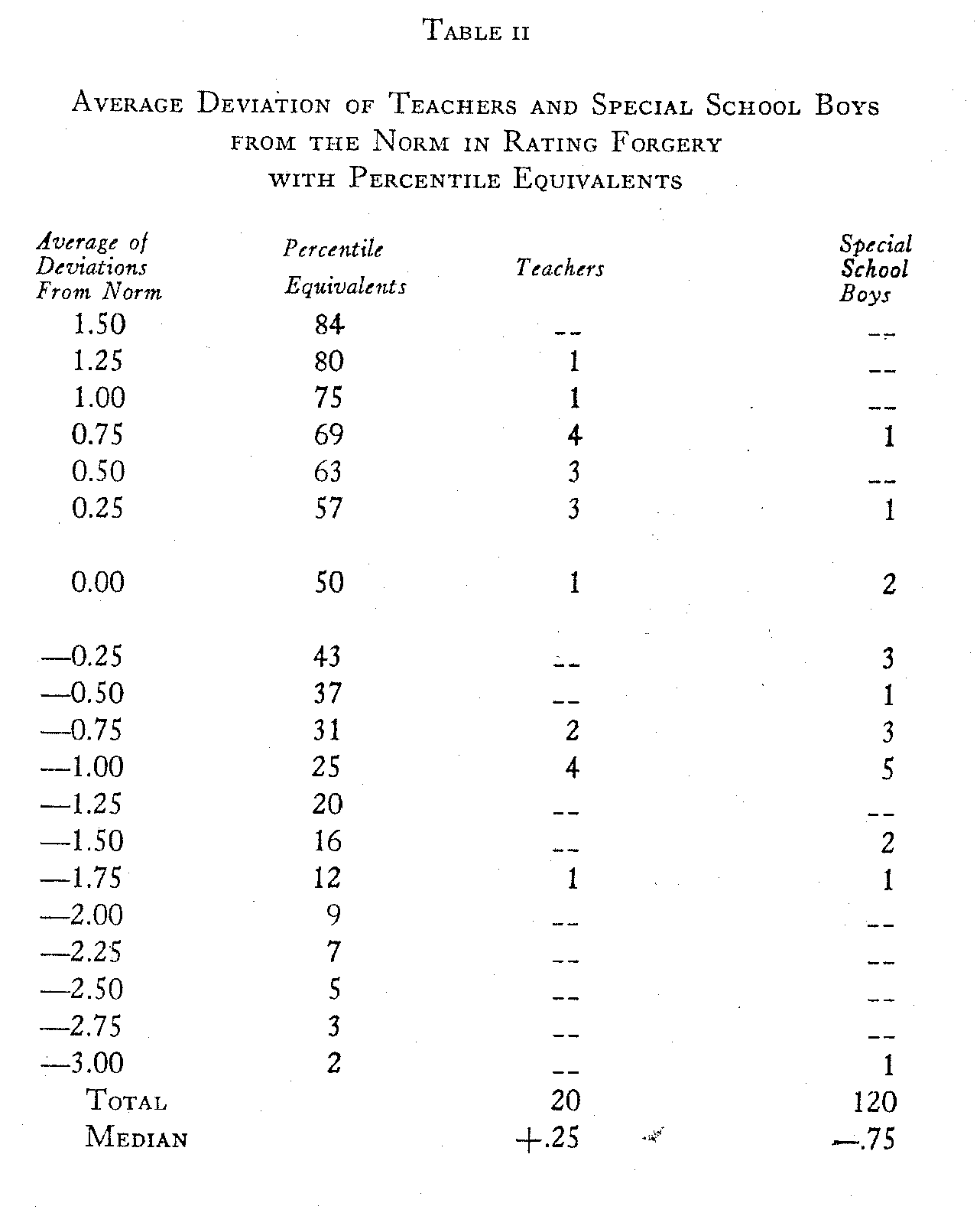The Measurement of Social Attitudes
Willis W. Clark
Department of Educational Research, Los Angeles City Schools
Lecturer in Sociology, University of Southern California
SOCIAL attitudes have a place of fundamental importance in social life, and their study should become one of the primary objectives of social psychological effort. Social attitudes are tendencies to act with reference to some phase of associative life.[1] According to Thomas, the attitudes which are more or less generally found among the members of a social group, which have a real importance in the life organization of the individuals who have developed them, and which manifest themselves in the social activities of these individuals practically comprise the field of social psychology.[2]
The scientific study of social attitudes involves the use of techniques which are characteristic of all scientific procedure, namely, objective methods of investigation, interpretation, and evaluation.
The social attitudes of an individual may be determined by two general methods of investigation each of which is inductive and each of which permits considerable variation in technique. The first includes the study of behavior and experiences while the second method attempts a direct de-termination of attitudes. A thorough-going study will undoubtedly make use of a combination of the two methods.
The first type of investigation involves the accurate description of behavior (which will imply certain attitudes)
( 346) and of experiences (which are preliminary to the development of attitudes). The procedures are similar to those of the social case history and life history with the necessary examination of source materials, including correspondence, various documents, public records, newspaper items, etc., and the interviewing of first-hand informational sources, particularly the individual being studied and those who have definite information concerning the experiences and behavior of this individual. An outline of possible sources of information is suggestive of the variety of sources which may be available in different cases.[3]
I. Family sources
II. Acquaintances
III. Employment sources
IV. Documentary sources
V. Legal sources
VI. Professional sources
VII. Institution sources
VIII. The investigator as a source
In securing any data there should be a definite effort to use objective methods of recording data (1) by the use of descriptive words and phrases which have a definite meaning, and (2) by the use of standardized tests, scales, and other measuring instruments.
The second method of investigation is that which endeavors to arrive at a direct determination of attitudes. As attitudes are subjective, this method involves the securing of data directly from the person concerned by interview, examination, or investigation of written materials which may express his attitudes. The principal methods of se-curing direct data concerning attitudes are the following: (1) obtaining expressions of opinion or judgments, (2) obtaining answers to questions in a questionnaire, (3) securing an expression as to the truth or falsity of a given
( 347) statement, (4) obtaining an indication of a person's choice of a series of possible specific attitudes concerning a given social value, (5) devising methods which will indirectly indicate the person's attitude.
(1) Expressions of opinion or judgments which are intended to convey attitudes may readily be obtained by examination of the writings of an individual or by conversational methods. It is obviously essential for obtaining satisfactory results by this method that the investigator have his field of inquiry well organized and that he have a satisfactory working knowledge of the field which he endeavors to investigate.
(2) The questionnaire method is, at best, of limited service in the investigation of attitudes. Its principal value lies in the securing of relatively simple data which may be answered in terms of time, space, and position, or by numbers, or by affirmation and negation. When a questionnaire is so thoroughly worked out that social attitudes may be indicated by a check mark or simple answer, it is usually known as a "True-false" test.
(3) "True-false" statements may be used to indicate attitudes if they are properly devised. The method of voting on various civic issues such as municipal ownership, bond issues, a referendum, etc., illustrates a common use of this type of investigation. For social research purposes, it is essential that any statement presented for the purpose of determining attitude by an expression of truth or falsity must be unitary and not susceptible to a variety of interpretations. Almost every social value may be analyzed in terms of a variety of effects which it is presumed to have on the various aspects of social welfare. To obtain an adequate idea of any person's general attitude of a given social value, it is necessary to secure a sufficient number of specific attitudes concerning this value so that the com-
( 348) -posite of the specific attitudes will be the equivalent of the general attitude .[4]
(4) An individual's evaluation of a series of specific situations may be used to indicate his attitudes. Here again it is essential that the situations shall be of sufficient variety to cover the field of inquiry. The ability of a person to rate the relative value, significance, quality, seriousness, etc., of given situations may be used as an indication of his attitudes. These situations might be descriptions of misbehavior, good behavior, occupational activity, etc. The writer has prepared a series of statements concerning juvenile offenses which will illustrate this method.[5] These offenses have been evaluated in terms of social consequence and certain typical offenses have been selected for a test of judgment of social consequences. The opinions expressed as to the relative seriousness of any given offense probably indicate an individual's attitude towards of-fenders of this type or towards this type of offense. A sample of this test is presented herewith:
GROUP I
Directions: After reading the statements of offenses, number each in order of social consequence, from 1 (least serious) to 7 (most serious). Give each offense a different number.
Sent to parental school because he struck teacher; accused of drawing knife on a boy whose bicycle he had stolen, when the boy claimed it; arrested for carrying a black-jack and knife _____
Signed name of employer to recommendation which he had written for himself Had stolen diamonds and jewelry on several occasions to value of $3,000_____
Habitually runs away from home and keeps late hours, very unsatisfactory record in school; disobedient at
( 349)
home, continually giving parents trouble by failing to return home promptly from school and refusing to obey; this conduct continued for a period of six years_____
Stole watch and knife to value of $25 _____
Ran away from orphanage and went to work with a circus _____
Took one dollar from father's cupboard_____
Data concerning attitudes of two groups—delinquent boys and teachers—as indicated by ratings of the above offenses and certain other offenses are presented in Table I.

(350)

Although the table is self explanatory, a few items are worthy of special mention. It is seen that special school boys considered offenses IV, VI, and X more serious than the teachers did. On the other hand, offenses II, VIII, and IX were considered to be of more consequence by teachers than by special school boys. For the other offenses there were no marked average differences. In nearly all instances there was more variability in opinions by the group
( 351) of special school boys than by the teachers. Offenses concerning running away (VI and X) were consistently considered relatively serious by special school boys; offenses against chastity (VIII and IX) were, on the average, considered of markedly less consequence by the boys than by teachers. Additional verification of significant variation in the attitude of both boys and teachers would be furnished by comparing their average with the norms [6] for each offense from I to X, which are respectively: 6.5, 4.5, 7.5, 3.5, 5.5, 2.5, 5.5, 7.5, and 1.5. As would be expected, the average opinion of teachers more nearly approximates the norm than does the average attitude of special school boys.
(5) An adequate method of determining attitudes directly will require
considerable ingenuity in devising tests which may be used to indicate attitudes
without the examinee's knowledge. For example, if it were desired to obtain a
given individual's attitude concerning forgery, a series of descriptions of
behavior concerning this offense might be inserted in groups of other types of
delinquent acts. After the ratings have been made, his attitude concerning these
offenses might be singled out for interpretation. It would be a relatively
simple matter to determine whether he had a lenient, moderate, or strict
attitude concerning forgery. Four descriptions of forgery inserted in groups of
offenses, similar to the group given above, and rated by teachers and special
school boys illustrate the method. These statements of forgery are as follows :
Signed name of employer to recommendation which he had written for himself.
Gave several bad checks in payment for gasoline to run automobile.
( 352)
Forged check for $100, signing father’s name.
Forged endorsement on $25 check payable to grandmother.
The offenses had been previously evaluated in terms of social consequences so that it was possible to determine the deviation of any individual's rating from a norm. Table II presents the average deviation of the four ratings for

(353) twenty teachers and twenty special school boys. The validity of the method is indicated by the fact that we would normally expect school boys to consider the offense of forgery as less serious than it would be considered by teachers. It is seen that there is a definite tendency for teachers to consider forgery more serious than special school boys do. The amount of difference is indicated by +.25 and –.75. This may be interpreted by the method of construction of the test to be equal to 1 Probable Error or twenty-five per cent, as a difference of 1 in average deviation is 1 P. E., which is equivalent to twenty-five per cent. It may be further interpreted to indicate that on the average, teachers consider forgery of greater seriousness than the norm, and that the average special school boy considers it of less consequence than the norm. This standardization of values could hardly have been effected other than by statistical methods which are a development in mathematical terms of the principles of logic and reduce the probability of many of the most serious logical fallacies.[7] It is possible that there is a definite relation between the formation of certain attitudes and such factors, as age, sex, intelligence level, temperament, race, etc.
In evaluating the attitudes of any group or the relative significance of various attitudes, objective methods should be continuously applied. Recent developments in increasing the objectivity of evaluation by the use of scales, standards, standard score sheets, percentile charts, T scores, etc. are well known and are undoubtedly recognized as desirable instruments of precision in the scientific study of social life.
Despite the complexity of the problem, the measurement of attitudes is of fundamental importance in the establish-
( 354) -ment of a science of social psychology and for social telesis. Progress in the technique of measurement will be made through a gradual increase in understanding of the inter-social relationships and of the coexistence and sequence of causes and effects. The application of scientific methods will result in better investigation which will permit more accurate interpretations ; these interpretations, in turn, will reflect back and improve investigational procedures. A proper coordination of the methods of investigation and evaluation of data will undoubtedly result in techniques of social research which may be truthfully called scientific.